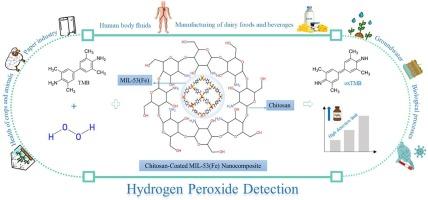Surface-engineered chitosan-coated MIL-53(Fe) nanozyme with synergistic effect on peroxidase/oxidase mimic as a highly sensitive biosensor for the colorimetric detection of hydrogen peroxide
IF 4.9
Q1 CHEMISTRY, ANALYTICAL
引用次数: 0
Abstract
The iron-based metal-organic framework (MOF) MIL-53(Fe) was successfully functionalized with chitosan through a simple and efficient post-synthetic strategy. This facile modification significantly enhances its catalytic properties, yielding a multifunctional nanocomposite that mimics both peroxidase and oxidase enzymatic activities. The chitosan-coated MIL-53(Fe), an inexpensive and biocompatible material, exhibits superior peroxidase-mimetic catalytic activity compared to its unmodified counterpart, enabling highly sensitive colorimetric biosensing. Upon interaction with hydrogen peroxide (H2O2), the nanocomposite facilitates the catalytic oxidation of 3,3′,5,5′-tetramethylbenzidine (TMB), producing a deep blue solution with distinct UV–vis absorption peaks at 369 and 652 nm. This system demonstrates a detection limit of 0.3 μM. Furthermore, our optimized catalytic conditions (40 °C, pH 4.0, 10 min, catalyst concentration: 0.11 mg mL−1) underscore the remarkable efficiency of our MOF-based peroxidase mimic. Notably, both peroxidase and oxidase activities are seamlessly executed under identical reaction conditions, simplifying multi-step enzymatic processes and eliminating the need for separate optimization protocols. This unique feature enhances overall efficiency while significantly reducing operational costs. The intrinsic rapid catalytic kinetics, reflected in the high Vmax values of 147.77 × 10−8 Ms.−1 for H2O2 and 53.11 × 10−8 Ms.−1 for TMB, further reinforce the system's viability for real-time sensing applications. Our functionalized MIL-53(Fe) nanocomposite presents a groundbreaking advancement in MOF-based biomimetic catalysis, with high sensitivity, operational simplicity, and cost-effectiveness. Finally, due to the excellent catalytic activity of chitosan-coated MIL-53(Fe), it was successfully utilized to detect H2O2 in real samples, including tap water and well water.

表面工程壳聚糖包被MIL-53(Fe)纳米酶对过氧化物酶/氧化酶模拟物具有协同作用,可作为过氧化氢比色检测的高灵敏度生物传感器
通过简单高效的后合成策略,壳聚糖成功地实现了铁基金属有机骨架(MOF) MIL-53(Fe)的功能化。这种简单的修饰显著提高了其催化性能,产生了一种多功能纳米复合材料,可以模拟过氧化物酶和氧化酶的酶活性。壳聚糖包覆的MIL-53(Fe)是一种廉价的生物相容性材料,与未经修饰的对应物相比,具有优越的过氧化物酶模拟催化活性,实现了高灵敏度的比色生物传感。在与过氧化氢(H2O2)相互作用后,纳米复合材料促进了3,3 ',5,5 ' -四甲基联苯胺(TMB)的催化氧化,生成了在369和652nm处具有明显紫外-可见吸收峰的深蓝色溶液。该系统的检测限为0.3 μM。此外,我们优化的催化条件(40°C, pH 4.0, 10 min,催化剂浓度:0.11 mg mL - 1)强调了我们基于mof的过氧化物酶模拟物的显着效率。值得注意的是,过氧化物酶和氧化酶的活性在相同的反应条件下无缝地执行,简化了多步酶催化过程,消除了单独优化方案的需要。这一独特功能提高了整体效率,同时显著降低了运营成本。固有的快速催化动力学,反映在H2O2的高Vmax值为147.77 × 10−8 Ms.−1,TMB的Vmax值为53.11 × 10−8 Ms.−1,进一步增强了系统在实时传感应用中的可行性。我们的功能化MIL-53(Fe)纳米复合材料在基于mof的仿生催化方面取得了突破性进展,具有高灵敏度、操作简单和成本效益。最后,由于壳聚糖包被的MIL-53(Fe)具有优异的催化活性,成功地用于检测自来水和井水等实际样品中的H2O2。
本文章由计算机程序翻译,如有差异,请以英文原文为准。
求助全文
约1分钟内获得全文
求助全文
来源期刊

Sensing and Bio-Sensing Research
Engineering-Electrical and Electronic Engineering
CiteScore
10.70
自引率
3.80%
发文量
68
审稿时长
87 days
期刊介绍:
Sensing and Bio-Sensing Research is an open access journal dedicated to the research, design, development, and application of bio-sensing and sensing technologies. The editors will accept research papers, reviews, field trials, and validation studies that are of significant relevance. These submissions should describe new concepts, enhance understanding of the field, or offer insights into the practical application, manufacturing, and commercialization of bio-sensing and sensing technologies.
The journal covers a wide range of topics, including sensing principles and mechanisms, new materials development for transducers and recognition components, fabrication technology, and various types of sensors such as optical, electrochemical, mass-sensitive, gas, biosensors, and more. It also includes environmental, process control, and biomedical applications, signal processing, chemometrics, optoelectronic, mechanical, thermal, and magnetic sensors, as well as interface electronics. Additionally, it covers sensor systems and applications, µTAS (Micro Total Analysis Systems), development of solid-state devices for transducing physical signals, and analytical devices incorporating biological materials.
 求助内容:
求助内容: 应助结果提醒方式:
应助结果提醒方式:


